
The moose or elk is the only species in the genus Alces. The moose is the tallest and second-largest land mammal in North America, only falling short of the American buffalo in terms of mass. It is the largest and heaviest extant species of deer. Most adult male moose have distinctive broad, palmate antlers; most other members of the deer family have antlers with a dendritic ("twig-like") configuration. Moose typically inhabit boreal forests and temperate broadleaf and mixed forests of the Northern Hemisphere in temperate to subarctic climates. Hunting and other human activities have caused a reduction in the size of the moose's range over time. It has been reintroduced to some of its former habitats. Currently, most moose occur in Canada, Alaska, New England, New York State, Fennoscandia, the Baltic states, Poland, Kazakhstan, and Russia.
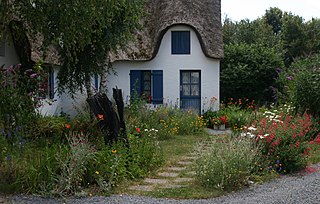
A wildlife garden is an environment created with the purpose to serve as a sustainable haven for surrounding wildlife. Wildlife gardens contain a variety of habitats that cater to native and local plants, birds, amphibians, reptiles, insects, mammals and so on, and are meant to sustain locally native flora and fauna. Other names this type of gardening goes by can vary, prominent ones being habitat, ecology, and conservation gardening.
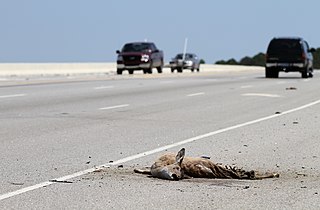
Roadkill is an animal or animals that have been struck and killed by drivers of motor vehicles. Wildlife-vehicle collisions (WVC) have increasingly been the topic of academic research to understand the causes, and how it can be mitigated.

Urban ecology is the scientific study of the relation of living organisms with each other and their surroundings in an urban environment. An urban environment refers to environments dominated by high-density residential and commercial buildings, paved surfaces, and other urban-related factors that create a unique landscape. The goal of urban ecology is to achieve a balance between human culture and the natural environment.

Wildlife crossings are structures that allow animals to cross human-made barriers safely. Wildlife crossings may include underpass tunnels or wildlife tunnels, viaducts, and overpasses or green bridges ; amphibian tunnels; fish ladders; canopy bridges ; tunnels and culverts ; and green roofs.
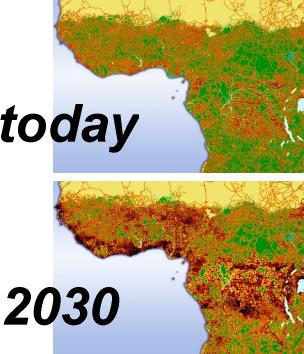
Habitat fragmentation describes the emergence of discontinuities (fragmentation) in an organism's preferred environment (habitat), causing population fragmentation and ecosystem decay. Causes of habitat fragmentation include geological processes that slowly alter the layout of the physical environment, and human activity such as land conversion, which can alter the environment much faster and causes the extinction of many species. More specifically, habitat fragmentation is a process by which large and contiguous habitats get divided into smaller, isolated patches of habitats.

The ecological restoration of islands, or island restoration, is the application of the principles of ecological restoration to islands and island groups. Islands, due to their isolation, are home to many of the world's endemic species, as well as important breeding grounds for seabirds and some marine mammals. Their ecosystems are also very vulnerable to human disturbance and particularly to introduced species, due to their small size. Island groups, such as New Zealand and Hawaii, have undergone substantial extinctions and losses of habitat. Since the 1950s several organisations and government agencies around the world have worked to restore islands to their original states; New Zealand has used them to hold natural populations of species that would otherwise be unable to survive in the wild. The principal components of island restoration are the removal of introduced species and the reintroduction of native species.

The black-tailed prairie dog is a rodent of the family Sciuridae found in the Great Plains of North America from about the United States-Canada border to the United States-Mexico border. Unlike some other prairie dogs, these animals do not truly hibernate. The black-tailed prairie dog can be seen above ground in midwinter. A black-tailed prairie dog town in Texas was reported to cover 25,000 sq mi (64,000 km2) and included 400,000,000 individuals. Prior to habitat destruction, the species may have been the most abundant prairie dog in central North America. It was one of two prairie dogs described by the Lewis and Clark Expedition in the journals and diaries of their expedition.
Sensory ecology is a relatively new field focusing on the information organisms obtain about their environment. It includes questions of what information is obtained, how it is obtained, and why the information is useful to the organism.
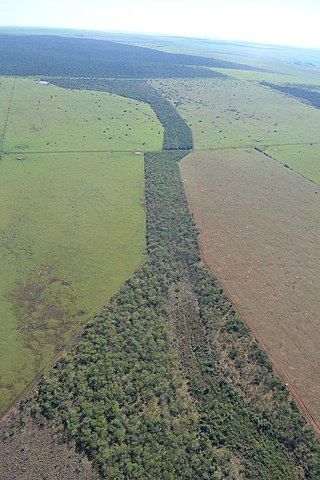
A wildlife corridor, habitat corridor, or green corridor is an area of habitat connecting wildlife populations separated by human activities or structures. This allows an exchange of individuals between populations, which may help prevent the negative effects of inbreeding, and reduced genetic diversity that often occur within isolated populations. Corridors may also help facilitate the re-establishment of populations that have been reduced or eliminated due to random events. This may potentially moderate some of the worst effects of habitat fragmentation, wherein urbanization can split up habitat areas, causing animals to lose both their natural habitat and the ability to move between regions to access resources. Habitat fragmentation due to human development is an ever-increasing threat to biodiversity, and habitat corridors serve to manage its effects.

Geographic Information Systems (GIS) has become an integral part of aquatic science and limnology. Water by its very nature is dynamic. Features associated with water are thus ever-changing. To be able to keep up with these changes, technological advancements have given scientists methods to enhance all aspects of scientific investigation, from satellite tracking of wildlife to computer mapping of habitats. Agencies like the US Geological Survey, US Fish and Wildlife Service as well as other federal and state agencies are utilizing GIS to aid in their conservation efforts.
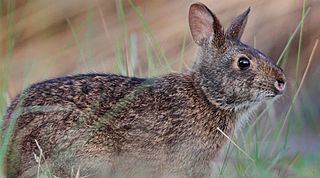
Sylvilagus palustris hefneri, also known commonly as the Lower Keys marsh rabbit, is an endangered subspecies of marsh rabbit in the family Leporidae. The subspecies is named after Playboy founder Hugh Hefner.

Riparian-zone restoration is the ecological restoration of riparian-zonehabitats of streams, rivers, springs, lakes, floodplains, and other hydrologic ecologies. A riparian zone or riparian area is the interface between land and a river or stream. Riparian is also the proper nomenclature for one of the fifteen terrestrial biomes of the earth; the habitats of plant and animal communities along the margins and river banks are called riparian vegetation, characterized by aquatic plants and animals that favor them. Riparian zones are significant in ecology, environmental management, and civil engineering because of their role in soil conservation, their habitat biodiversity, and the influence they have on fauna and aquatic ecosystems, including grassland, woodland, wetland or sub-surface features such as water tables. In some regions the terms riparian woodland, riparian forest, riparian buffer zone, or riparian strip are used to characterize a riparian zone.
Road ecology is the study of the ecological effects of roads and highways. These effects may include local effects, such as on noise, water pollution, habitat destruction/disturbance and local air quality; and the wider environmental effects of transport such as habitat fragmentation, ecosystem degradation, and climate change from vehicle emissions.
Located in the southern part of British Columbia, Columbia National Wildlife Area was established to protect its wetlands and as a temporary home for migratory birds travelling to South America. The National Wildlife Area (NWA) is divided into four unit areas: Wilmer, Spillimacheen, Brisco and Harrogate, which are home to many diverse species of animals and plants which are significant in Canada.
Garden waste, or green waste dumping is the act of discarding or depositing garden waste somewhere it does not belong.

Linear infrastructure intrusions into natural ecosystems are man-made linear infrastructure such as roads and highways, electric power lines, railway lines, canals, pipelines, firebreaks, and fences. These intrusions cause linear opening through the habitat or breakage in landscape connectivity due to infrastructure creation and maintenance, which is known to have multiple ecological effects in terrestrial and aquatic ecosystems. These effects include habitat loss and fragmentation, spread of invasive alien species, desiccation, windthrow, fires, animal injury and mortality, changes in animal behaviour, pollution, microclimate and vegetation changes, loss of ecosystem services, increased pressures from development, tourism, hunting, garbage disposal, and associated human disturbances. These intrusions, considered crucial infrastructure for economic sectors such as transportation, power, and irrigation, may also have negative social impacts on indigenous and rural people through exposure to novel social and market pressures, loss of land and displacement, and iniquitous distribution of costs and benefits from infrastructure projects. The study of the ecological effects of linear infrastructure intrusions has spawning sub-fields of research such as road ecology and railroad ecology.

The barrier effect of roads and highways is a phenomenon usually associated with landscape ecology, referring to the barrier that linear infrastructure like roads or railways place on the movement of animals. Largely viewed as a negative process, the barrier effect has also been found to have several positive effects, particularly with smaller species. To reduce a road or railway's barrier effect, wildlife crossings are regarded as one of the best mitigation options, ideally in combination with wildlife fencing. The barrier effect is closely linked to habitat fragmentation and road ecology.
Many animal migration patterns are still intact in the greater Jackson area due to the large quantity of protected land. Large animals such as elk, mule deer, and pronghorn have separate winter and summer habitats and are moving in the spring and fall. Elk, moose, and other large animals also converge in the low-lying areas around Jackson during the winter months to escape deep snow at higher elevations. All of this movement increases the likelihood of wildlife-vehicle collisions on roads.
A roadkill hotspot or blackspot is an accumulation of roadkill along a given length of roadway with significantly more wildlife-vehicle collisions than expected to occur by chance, based on a normal distribution. Decision-makers can then authorize the construction of roadkill mitigation infrastructure based on roadkill hotspot locations, prioritizing those with the most roadkill in number or those for a particular target species for conservation. Roadkill hotspots vary spatially and temporally, depending on the scale, duration of monitoring, and both the species and season in question. They can be calculated using roadkill survey data; GPS coordinates of roadkill collected by researchers and highway maintenance personnel, or increasingly, civilian-reported data. Additionally, roadkill hotspots can be projected by using a model to ascertain probable locations; models typically use existing wildlife abundance, distribution, and mitigation data combined with landscape variables and climatic data. Models are often used to determine the probable roadkill locations of ecologically sensitive animals or during the planning stages of a new road, it is noted that these locations may not align perfectly with sites of highest animal crossing attempts. Many academics stress the combined value of animal abundance and migration data with roadkill hotspots as a more assured way to ascertain the best locations to construct roadkill mitigation structures.
















